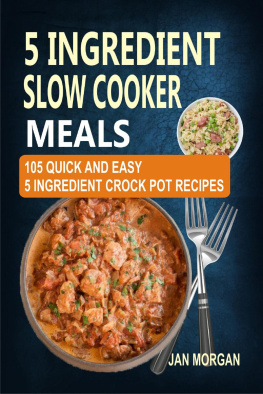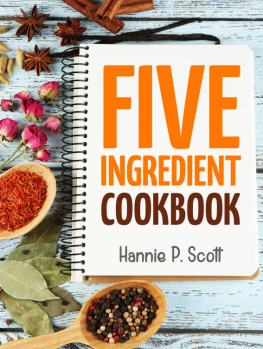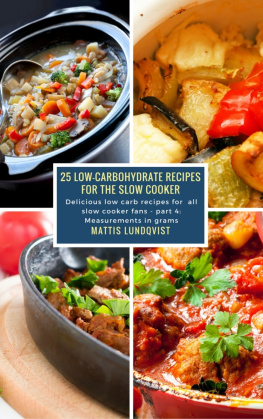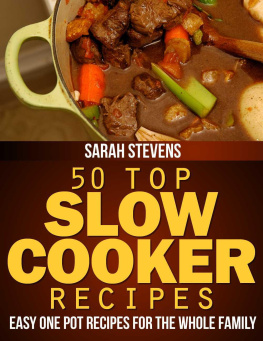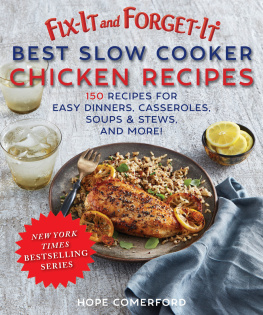3-INGREDIENT
SLOW COOKER
RECIPES
200 Recipes for Memorable Meals
SUZANNE BONET

Text 2005 by Suzanne Bonet
First published in the USA in 2005 by
Fair Winds Press, a member of
Quayside Publishing Group
100 Cummings Center
Suite 406-L
Beverly, MA 01915
All rights reserved. No part of this book may be reproduced or utilized, in any form or by any means, electronic or mechanical, without prior permission in writing from the publisher.
09 08 07 2 3 4 5
ISBN - 13: 978-1-59233-180-2
ISBN - 10: 1-59233-180-7
Digital edition: 978-1-61673-790-0
Softcover edition: 978-1-59233-180-2
Library of Congress Cataloging-in-Publication Data
Bonet, Sue.
3-ingredient slow cooker recipes / Sue Bonet.
p. cm.
ISBN 1-59233-180-7
1. Electric cookery, Slow. 2. Quick and easy cookery. I. Title: Three-ingredient slow cooker recipes. II. Title.
TX827.B66 2005
641.5884--dc22
2005024259
Cover design by Ariana Dingman
Cover illustration by Jessica Allen
Book design by Leslie Haimes
Printed and bound in USA
The information in this book is for educational purposes only. It is not intended to replace the advice of a physician or medical practitioner. Please see your health care provider before beginning any new diet or health program.

This book is dedicated to the memories of
my mother and brother, whom I deeply miss;
to my daughters, Christina and Clarissa;
and to my sweetheart, Jim.
My motivation to perfect the quick-and-easy
slow-cooker recipe stemmed from my desire to
spend more time with all of you.
Contents
Introduction

C hic is a term wholly dissociated from the slow cooker, yet the popularity of the lowly slow cooker is on the upswing. A growing health-consciousness and desire to simplify are lifestyle reasons for the slow cookers rediscovery.
But other reasons exist, too. Whats nicer than coming home to the aroma of Rosemary-Lamb Stew () after a long day away? Cheaper cuts of meat taste tender and moist after slow cooking, and this helps with the budgetary stresses felt by graduate students, young adults, and growing families. Time-stressed households want to eat in, but they dont want freezer food, pizza, and microwave-centered meals day after day. They yearn for the flavorful, home-prepared variety. Everyone today seems to be strapped for time and money and togetherness. Yes, everyone is on the lookout for flavorful yet simple foods whose preparation doesnt take time away from family, school, career, or hobbies.
So, its time to scramble to the back of the pantry and retrieve the appliance youve been snubbing, being a person of high culinary goals. Dont look now, but cheaper cuts of meat are suddenly chic at the countrys best restaurants. It seems everyone is discovering that lamb shanks, pot roast, and brisket are mighty tasty when cooked right, and were here to help you figure out how to do that.
Why just three ingredients? Because the recipes in this collection were selected to ensure that the slow cooker is utilized as intendedas an appliance that makes your life easier, simpler, less costly, and more satisfying. The problem with most slow-cooker recipes is that they expect too much from you. They require lots of ingredients and steps before you fix it and forget it. Not the recipes in this collection. These truly are simple recipes, featuring only three ingredients, not counting water, salt, and black pepper. Best of all, these recipes are memorable, not mushy!
Chapter 1
Getting to Know Your Slow Cooker
Slow Cooker Types, Sizes, Features, and Safety
S low cookers were introduced in the 1970s, and to date, more than 100 million have been sold. The Crock-Pot was the original slow cooker, and it still makes up 85 percent of the market. The catchy brand name, belonging to the Rival Company, became synonymous with the slow cooker. Today, we may still forget and call slow cookers by the wrong name, but that doesnt change the facts: All Crock-Pots are slow cookers, but not all slow cookers are Crock-Pot brand. Cuisinart, Farberware, Hamilton Beach, West Bend, and many other companies manufacture slow cookers as well.
What exactly is a slow cooker? Its a small, stand-alone appliance that cooks food slowly in a ceramic pot. The slow cookers heating element surrounds the food with heat, so that the food cooks evenly. This eliminates the need to stir the cooking food, making its preparation extremely convenient for the cook. Some slow cooker-type appliances have heat coils on the bottom only, as well as adjustable thermostats. These are not true slow cookers, however. If you have this type of cooker, refer to your product manual for advice on how to adapt the recipes in this cookbook.
When first introduced, slow cookers came with two settings, LOW and HIGH, which most slow cookers still have. The exact temperatures of these settings vary by manufacturer, but LOW is generally about 200F (90C) and HIGH is about 300F (150C). These temperatures, though low in comparison to those used in conventional cooking, exceed food-safety standards.
For most slow-cooker recipes, its possible to set the slow cooker to LOW and leave it unattended for the length of the recommended cooking time. But while the cooking times are flexible, it is possible that unexpected delaysgetting stuck in a major traffic jam, for instancecould result in overcooked food. Many of the newer slow cookers therefore are programmable and often come with a WARM temperature setting, which is approximately 140F (60C), to prevent overcooking and to keep food at a safe temperature for up to four hours. This feature is also convenient if you want to hold foods at serving temperature for late-arriving family members or at potluck gatherings.
Even if you have a basic slow cooker with only a LOW and a HIGH temperature setting, the Rival Company sells a remarkable device called the Smart-Part Module. This little item works like a timer. Just insert the plug of your slow cooker into the module and set the cooking time. The module will automatically switch your slow cooker to WARM when your meal is finished cooking. It works with any brand of slow cooker that has a ceramic pot and that is rated 400 watts (3.3 amps) or less.
Slow Cookers and Bacteria
The slow cookers lengthy cooking time, its direct heat, and the steam locked inside the pot thanks to its tight-fitting lid all work in concert to destroy bacteria when commonsense food-handling procedures are followed. In the 1970s, when slow cookers were first introduced, some people unknowingly practiced unsafe food-handling procedures and promoted the growth of enough bacteria in their slow-cooked food to cause illness. These days, slow cookers operate at higher temperatures, killing bacteria faster and better. In addition, the kitchen seems to have been affected by the postSeptember 11 safety revolution. Now everybody is all about practicing safetyincluding food safety.
Although most slow-cooker food-safety practices are common sense, you probably need to refresh your memory. So, take a peek at the food-safety tips on . Youll be glad you did.
The Basic Slow Cooker
When shopping for a new slow cooker, its easy to become overwhelmed by the many types of cookers and variety of features available. Therefore, its useful to understand the components of a basic slow cooker.


